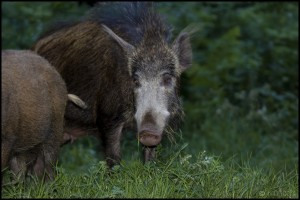Wild boars reside mostly in Northern Europe, Central Europe, and the Mediterranean Region, including Africa’s Atlas Mountains. For the purpose of hunting, wild boars have been artificially introduced into the Americas and some parts of Australia. They are noted for having larger heads in proportion to their bodies and also contain a conglomeration of stiff bristles along with finer fur, usually varying in color from dark grey, brown, and black.

Adult male boars are usually solitary animals outside of the breeding season. However, females and their offspring live together in groups called sounders. A sounder may consist anywhere from 20 to almost 50 boars, with a dominant female in the group. Wild boars are considered to be omnivorous scavengers, consuming anything from grass, berries, nuts, insects, or reptiles. They are also known to hunt young deer and lambs.
During mating season, males will move into female groups and rival other males for dominance. After a female has mated with a dominant male, the gestation period lasts for 115 days. After two hours of giving birth of up to six offspring, the mother will begin to wean her offspring from suckling after about four months. They will then commence to eating solid foods, such as worms and grubs.




